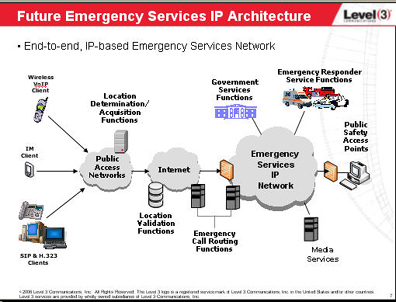Until this happens, VoIP E911 will be an illusion


At CTIA I attended a presentation on next-generation E911 for mobile VoIP.
Two of the presenters were Tim Lorello, SVP, Chief Marketing Officer, TeleCommunication Systems, Inc., and William Clay, Vice President E-911 Product Development at Level 3 Communications.
In one of Bill Clay's slides (shown at the top of this post), he stressed that a fully deployed mobile VoIP E911 solution should be able to:
Support End User Mobility
Support Any Internet-enabled End Points
Allow Medical Information, Video, etc. to be Passed During Session
Enhanced PSAP Capabilities (Transfers, etc.)
Disaster Recovery (Remote PSAPs)
Increase Reliability
Simplify Carrier Access to PSAPs
Then, in one of Tim's slides, he described the Automatic Location Determination technology necessary for "nomadic" E911 VoIP to work right.
Tim mentioned such imperatives as:
Mobility Detection
Network-generated location, Endpoint-generated location
Wiremap LIS (Location Information Server) integration
Here are more details about the near-term state of Wireless LIS, as described in the December, 2005 National Emergency Number Association document entitled NENA Interim VoIP Architecture for Enhanced 9-1-1 Services:
In some implementations, a LIS serves as a repository for location information. Location information is in the form of civic address or geo-spatial location attributes correlated with a particular physical location.
The LIS is configured with mappings between individual location information and a logical representation of the physical locations with which they are associated. This set of associations is called a “wiremap.”
The wiremap in the LIS is assumed to be configured and maintained by the entity that provides/maintains the physical or logical access facility for endpoint equipment. For examples, this might be an IT administrator for an enterprise, or an Internet Service Provider (ISP) or access provider in non-enterprise/residential VoIP markets. The administrator/owner of the LIS is responsible for creating and maintaining this wiremap, and for ensuring that the civic location data is MSAG (Master Street Address Guide)- validated.A given endpoint can be associated with a physical location that is mapped to a particular civic address or geo coordinates, and this information is downloaded from the LIS to the endpoint.
And here's how Tim visualizes the GEOPRIV (location element for identifying the location of a specific E911 caller) framework would look:
This needs to happen- and without all that bureaucratic red tape.
Until it does, VoIP E911 isn't really there.